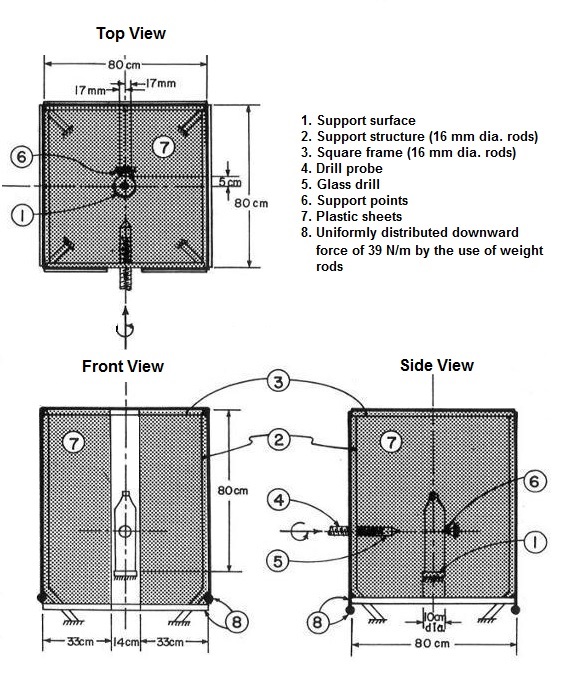Carbonated Beverage Glass Containers Regulations (SOR/2016-166)
Full Document:
- HTMLFull Document: Carbonated Beverage Glass Containers Regulations (Accessibility Buttons available) |
- XMLFull Document: Carbonated Beverage Glass Containers Regulations [20 KB] |
- PDFFull Document: Carbonated Beverage Glass Containers Regulations [554 KB]
Regulations are current to 2024-12-15
SCHEDULE 1(Section 2)Drill Test — Perforation
1 The following method is to be used to test whether a carbonated beverage glass container shatters in such a way as to cause perforation:
(a) as illustrated in the figure of the test apparatus, provide
(i) a flat and horizontal support surface that is 10 cm in diameter,
(ii) on a supporting structure of four corner posts 16 mm in diameter, four straight rods 16 mm in diameter, forming a square frame with outside dimensions of 80 cm for each side centred on the vertical centreline through the support surface and parallel to, and with the upper edges of the rods 80 cm above, the support surface,
(iii) a drill probe of adjustable height, with a horizontal axial centreline in a vertical plane that passes equidistant between two opposite sides of the square frame,
(iv) a sharp “MM Glazemaster Glass Drill, 4.5 mm, Type A”, affixed to and axially centred on the drill probe,
(v) a drill probe drive mechanism capable of rotating the probe 0.2 revolutions per second while advancing the drill 0.254 mm per second towards the vertical centreline through the support surface, and
(vi) two support points for the container of adjustable height, located and oriented as shown in the figure;
(b) cover the top and the four vertical sides of the supporting structure using clear polyethylene plastic sheets of a thickness of 0.035 ± 0.005 mm, and using supplementary means of attachment as required, so that
(i) a single sheet of plastic, 80 cm wide, is suspended across the side facing the drill probe,
(ii) two sheets of plastic, each 33 cm wide, are suspended on the side where the drill probe is located with a gap of 14 cm between the two sheets, symmetrical with the drill probe centreline,
(iii) a single sheet of plastic, 80 cm wide, is suspended across the top and the other two sides,
(iv) the lower edges of the plastic sheets extend below the plane of the support surface, and
(v) the lower edges of the plastic sheets are subjected to a uniformly distributed downward force of 39 N/m of width by the use of weight rods;
(c) remove from the container any packaging and label that does not remain on it after its sale and during its use;
(d) ensure that the unopened container is equilibrated to a test temperature by storing it in a water bath at 22°C for four hours and is equilibrated as to pressure at that temperature by ultrasonic agitation immediately before the test;
(e) ensure that the plastic sheets are free of any perforation;
(f) adjust the drill probe and the support points to the mid-height of the container;
(g) place the container upright and unopened on the support surface and against the support points;
(h) adjust the probe drive mechanism to a linear velocity of 0.254 mm per second and a rotational velocity of 0.2 revolutions per second, and advance the drill probe until it pierces the container; and
(i) if the container shatters, note whether any piece or part of the container has perforated the plastic sheets above the horizontal plane of the support surface.
Figure — Test Apparatus

- Date modified: